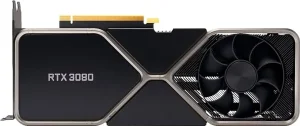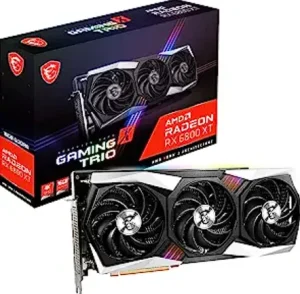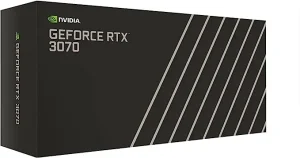5 Best graphics card for Oculus Quest 2 in 2024
Are you ready to take your virtual reality experience to the next level? Look no further! We’ve got the ultimate guide to finding the perfect graphics card for your Oculus Quest 2. Say goodbye to lag and hello to stunning visuals that will transport you into a whole new world. Whether you’re a gaming enthusiast or a casual user, we’ve got you covered. Get ready to dive into the world of VR like never before!
5 Best graphics card for Oculus Quest 2 in 2024
| Serial No. | Product Name | Check Price |
| 1 | NVIDIA GeForce RTX 3080 | Check Price |
| 2 | AMD Radeon RX 6800 XT | Check Price |
| 3 | NVIDIA GeForce RTX 3070 | Check Price |
| 4 | AMD Radeon RX 6700 XT | Check Price |
| 5 | NVIDIA GeForce RTX 3060 Ti | Check Price |
1. NVIDIA GeForce RTX 3080

| Specification | Details |
| GPU | NVIDIA GeForce RTX 3080 |
| Boost Clock Speed | 1710MHz |
| Video Memory | 10GB GDDR6X (320-bit) |
| PCI Express Compatibility | 4.0 and earlier 3.0 |
| Graphics Features | Antialiasing, Anisotropic Filtering |
| Connectivity | HDMI, Display Port |
One of the standout features of the NVIDIA GeForce RTX 3080 is its impressive boost clock speed of 1710MHz. This means that even the most demanding games run smoothly and seamlessly, with no lag or stuttering. You’ll feel fully immersed in the virtual world, with stunning visuals that bring your games to life.
The 10GB GDDR6X video memory ensures that you have more than enough power to handle even the most graphics-intensive games. Whether you’re exploring vast open worlds or engaging in fast-paced action, the NVIDIA GeForce RTX 3080 keeps up with ease, providing a smooth and immersive gaming experience.
Compatibility is never an issue with this graphics card. With support for both PCI Express 4.0 and earlier 3.0, you can rest assured that it will work seamlessly with a wide range of systems. Whether you’re upgrading your existing setup or building a new gaming rig, the NVIDIA GeForce RTX 3080 has got you covered.
The graphics features of this card, including antialiasing and anisotropic filtering, take your gaming experience to the next level. The visuals are incredibly realistic, with sharp and crisp images that make you feel like you’re right in the middle of the action. From the smallest details to the grandest vistas, every aspect of the game looks stunningly beautiful.
In terms of connectivity, the NVIDIA GeForce RTX 3080 offers both HDMI and Display Port outputs, giving you the flexibility to connect to a wide range of displays and devices. Whether you prefer gaming on a large TV screen or a high-resolution monitor, this graphics card ensures that you can enjoy your games in all their glory.
Pros:
- Exceptional boost clock speed for smooth and lag-free gaming.
- Ample 10GB GDDR6X video memory for handling graphics-intensive games.
- Broad compatibility with PCI Express 4.0 and earlier 3.0.
- Stunning graphics with antialiasing and anisotropic filtering.
- Versatile connectivity options with HDMI and Display Port outputs.
Cons:
- High power consumption.
- Can be expensive for budget-conscious buyers.
2. AMD Radeon RX 6800 XT

| Specification | Details |
| Chipset | Radeon RX 6800 XT |
| Video Memory | 16GB GDDR6 |
| Memory Interface | 256-bit |
| Output | DisplayPort x 3 (v1.4) / HDMI 2.1 x 1 |
| Digital Maximum Resolution | 7680 x 4320 |
The AMD Radeon RX 6800 XT is powered by a Radeon RX 6800 XT chipset, which ensures high performance and reliability. With 16GB of GDDR6 video memory and a 256-bit memory interface, this graphics card provides ample power to handle even the most demanding and graphics-intensive games. You’ll be immersed in a world of stunning visuals and smooth gameplay.
One notable feature of the Radeon RX 6800 XT is its impressive output options. With three DisplayPort 1.4 and one HDMI 2.1 port, you have the flexibility to connect to multiple displays simultaneously. Whether you prefer gaming on a large monitor or a TV screen, this graphics card has got you covered. The digital maximum resolution of 7680 x 4320 ensures that you can enjoy your games in breathtaking detail and clarity.
The AMD Radeon RX 6800 XT excels in delivering outstanding graphics performance. Games come to life with vibrant colors, sharp details, and realistic textures. The graphics are incredibly immersive, allowing you to fully immerse yourself in the virtual world. From the smallest details to the most expansive environments, every aspect of the game is rendered beautifully.
Pros:
- High-performance chipset for smooth and lag-free gaming.
- Generous 16GB GDDR6 video memory for handling graphics-intensive games.
- Multiple output options for versatile connectivity.
- Ability to drive high resolutions for stunning visuals.
Cons:
- Can be power-hungry.
- Availability and pricing may vary.
3. NVIDIA GeForce RTX 3070

| Specification | Details |
| Chipset | NVIDIA GeForce RTX 3070 Founders Edition |
| Architecture | Ampere (NVIDIA’s 2nd gen RTX architecture) |
| Boost Clock Speed | 1695MHz |
| Video Memory | 8GB GDDR6 (256-bit) |
| Outputs | HDMI, Display Port |
| PCI Express Compatibility | PCI Express 4.0 and earlier PCI Express 3.0 |
Powered by NVIDIA’s 2nd gen RTX architecture, Ampere, the GeForce RTX 3070 packs a punch when it comes to performance. With enhanced RT Cores and Tensor Cores, along with new streaming multiprocessors and high-speed G6 memory, this graphics card is built to handle even the most demanding games with ease. You can rip through virtual worlds and experience smooth gameplay like never before.
One of the standout features of the GeForce RTX 3070 is its impressive 1695MHz boost clock speed. This ensures that the GPU can meet the demands of demanding games and deliver a lag-free experience. With 8GB of GDDR6 video memory and a 256-bit memory interface, you can expect exceptional performance and stunning visuals.
The GeForce RTX 3070 excels in delivering striking graphics with incredible realism, thanks to its antialiasing and anisotropic filtering capabilities. Every detail is rendered with precision, immersing you in a virtual world that feels lifelike. Whether you’re exploring vast landscapes or engaging in intense battles, the graphics are sure to impress.
With HDMI and Display Port outputs, the GeForce RTX 3070 offers flexible connectivity options. Whether you prefer gaming on a monitor or a TV screen, you can easily connect and enjoy your favorite games. Additionally, the compatibility with both PCI Express 4.0 and earlier PCI Express 3.0 ensures that the graphics card can be used with a wide range of systems.
Pros:
- Powerful performance for demanding games.
- Enhanced RT and Tensor Cores for realistic graphics.
- Flexible connectivity options.
- Wide compatibility with different systems.
Cons:
- Availability may vary.
- Higher power consumption compared to previous generation GPUs.
4. AMD Radeon RX 6700 XT

| Specification | Details |
| Memory Speed | 16 Gbps |
| Digital Max Resolution | 7680×4320 |
| Package Weight | 2.0 Kg |
| Stream Processor | 2560 |
| Game Clock | 2514MHz (OC) / 2433MHz (Silent) |
| Boost Clock | 2633MHz (OC) / 2615MHz (Silent) |
| Additional Note | Avoid using unofficial software |
The AMD Radeon RX 6700 XT boasts an impressive array of specifications. With a memory speed of 16 Gbps and a digital max resolution of 7680×4320, this graphics card ensures crystal-clear visuals in your virtual world. The 2560 stream processors provide the necessary power to handle demanding games with ease, allowing you to immerse yourself in the action fully.
One of the standout features of the Radeon RX 6700 XT is its game clock, which can reach up to 2514MHz in OC mode and 2433MHz in Silent mode. This clock speed ensures a smooth and lag-free gaming experience, even during intense moments. Additionally, the boost clock can go up to 2633MHz in OC mode and 2615MHz in Silent mode, providing an extra performance boost when needed.
It is important to note that using unofficial software with the Radeon RX 6700 XT is not recommended. Stick to official drivers and software to ensure optimal performance and stability.
Pros:
- Impressive memory speed for smooth gameplay.
- High-resolution support for stunning visuals.
- Powerful stream processors for demanding games.
- Customizable clock speeds for optimized performance.
Cons:
- Avoiding unofficial software is necessary for stability.
5. NVIDIA GeForce RTX 3060 Ti

| Specification | Details |
| Graphics Coprocessor | NVIDIA GeForce RTX 3060 Ti |
| Brand | Geforce |
| Graphics Ram Size | 8 GB |
| GPU Clock Speed | 1665 MHz |
| Video Output Interface | PCI Express, HDMI, DisplayPort |
This card provides ample memory to handle even the most demanding VR games and applications. The GPU clock speed of 1665 MHz ensures smooth and responsive gameplay, allowing you to fully immerse yourself in the virtual world.
One of the key features of the GeForce RTX 3060 Ti is its compatibility with the Oculus Quest 2. With a PCI Express, HDMI, and DisplayPort video output interface, you can easily connect your VR headset and enjoy a seamless and immersive experience. Whether you’re exploring virtual worlds or engaging in intense multiplayer battles, this graphics card delivers stunning visuals and responsive gameplay.
Pros:
- Ample graphics RAM for smooth performance.
- High GPU clock speed for responsive gameplay.
- Compatible with Oculus Quest 2 for an immersive VR experience.
- Versatile video output interface for easy connectivity.
Cons:
- Limited availability may make it difficult to obtain.
Buying Guide: 6 Factors to Consider When Choosing the Best Graphics Card for Oculus Quest 2
Performance: The performance of the graphics card is paramount when it comes to virtual reality gaming. Look for a card with ample memory, high clock speeds, and powerful stream processors. These factors will ensure smooth and lag-free gameplay, allowing you to fully immerse yourself in the virtual world.
Compatibility: Ensure that the graphics card you choose is compatible with the Oculus Quest 2. Look for cards with video output interfaces such as HDMI or DisplayPort to connect your VR headset seamlessly. Compatibility ensures a hassle-free experience and avoids any technical issues.
Resolution and Refresh Rate: For an immersive VR experience, opt for a graphics card that supports high resolutions and refresh rates. The higher the resolution, the sharper and more detailed the visuals will be. Similarly, a higher refresh rate ensures smoother motion and reduces motion sickness. Aim for a card that can handle at least 1440p resolution and a refresh rate of 90Hz or higher.
Power Requirements: Graphics cards can be power-hungry, so it’s crucial to check the power requirements of the card you’re considering. Ensure that your power supply unit (PSU) can handle the graphics card’s power consumption. Insufficient power supply can lead to instability and performance issues.
Budget: Set a budget for your graphics card purchase. Determine how much you are willing to spend and look for options within that range. Remember, while it’s tempting to go for the top-of-the-line models, there are often more affordable options that still offer excellent performance for VR gaming.
Reviews and Recommendations: Before making a final decision, read reviews and seek recommendations from trusted sources. Look for feedback from other VR gamers who have used the graphics card you’re considering. Their experiences can provide valuable insights and help you make an informed decision.
FAQ’s
1. Can I use any graphics card with my Oculus Quest 2?
No, not all graphics cards are compatible with the Oculus Quest 2. It’s essential to ensure that the graphics card you choose has the necessary video output interfaces, such as HDMI or DisplayPort, to connect seamlessly with your VR headset.
2. How much graphics RAM do I need for the best VR gaming experience?
The amount of graphics RAM required depends on the complexity of the VR games you intend to play. As a general guideline, aim for a graphics card with at least 8 GB of RAM to ensure smooth performance and handle demanding VR applications.
3. Do I need to upgrade my power supply unit (PSU) for a high-end graphics card?
Upgrading your PSU might be necessary when opting for a high-end graphics card. These cards often require more power to operate efficiently. Check the power requirements of the graphics card you’re considering and ensure your PSU can handle the increased power consumption.
4. What is the importance of clock speed in a graphics card for VR gaming?
Clock speed plays a crucial role in determining the performance of a graphics card. Higher clock speeds result in faster processing and smoother gameplay. Look for a graphics card with a high clock speed to ensure a responsive and immersive VR gaming experience.
5. What resolution and refresh rate should I aim for in a graphics card for the Oculus Quest 2?
For optimal visual quality, aim for a graphics card that supports at least 1440p resolution and a refresh rate of 90Hz or higher. Higher resolutions provide sharper and more detailed visuals, while a higher refresh rate ensures smoother motion and reduces motion sickness during VR gameplay.
Conclusion
Choosing the best graphics card for your Oculus Quest 2 is a critical decision that can significantly enhance your virtual reality gaming experience. By considering factors such as performance, compatibility, resolution, power requirements, and budget, you can make an informed choice that suits your specific needs.
Whether you’re exploring breathtaking virtual worlds or engaging in intense multiplayer battles, a high-quality graphics card will provide smooth gameplay, stunning visuals, and an immersive adventure.
So, take your time, do thorough research, read reviews, and select the graphics card that will transport you to new realms of excitement and immersion. Get ready to unlock the full potential of your Oculus Quest 2 and embark on unforgettable virtual reality journeys!
